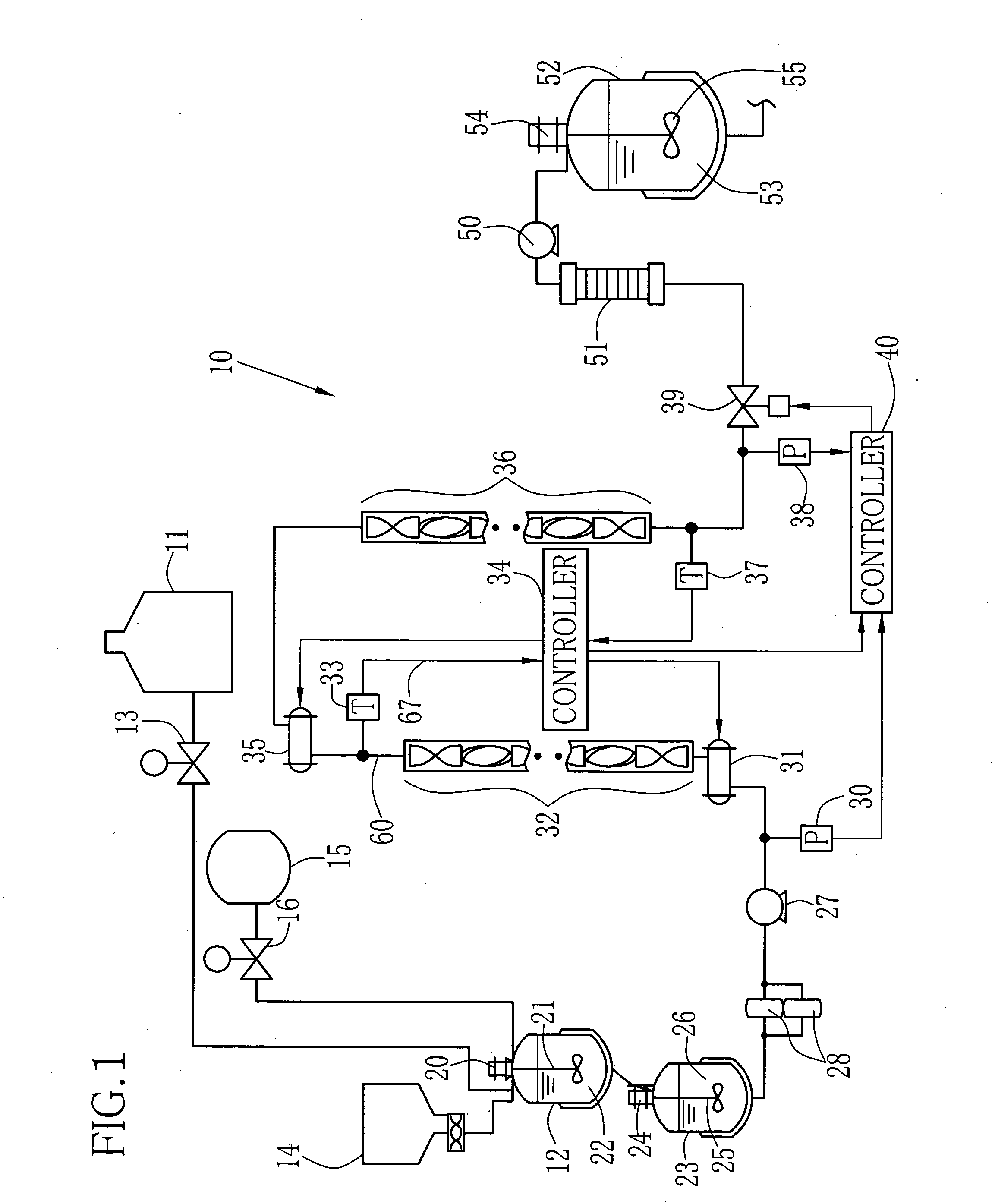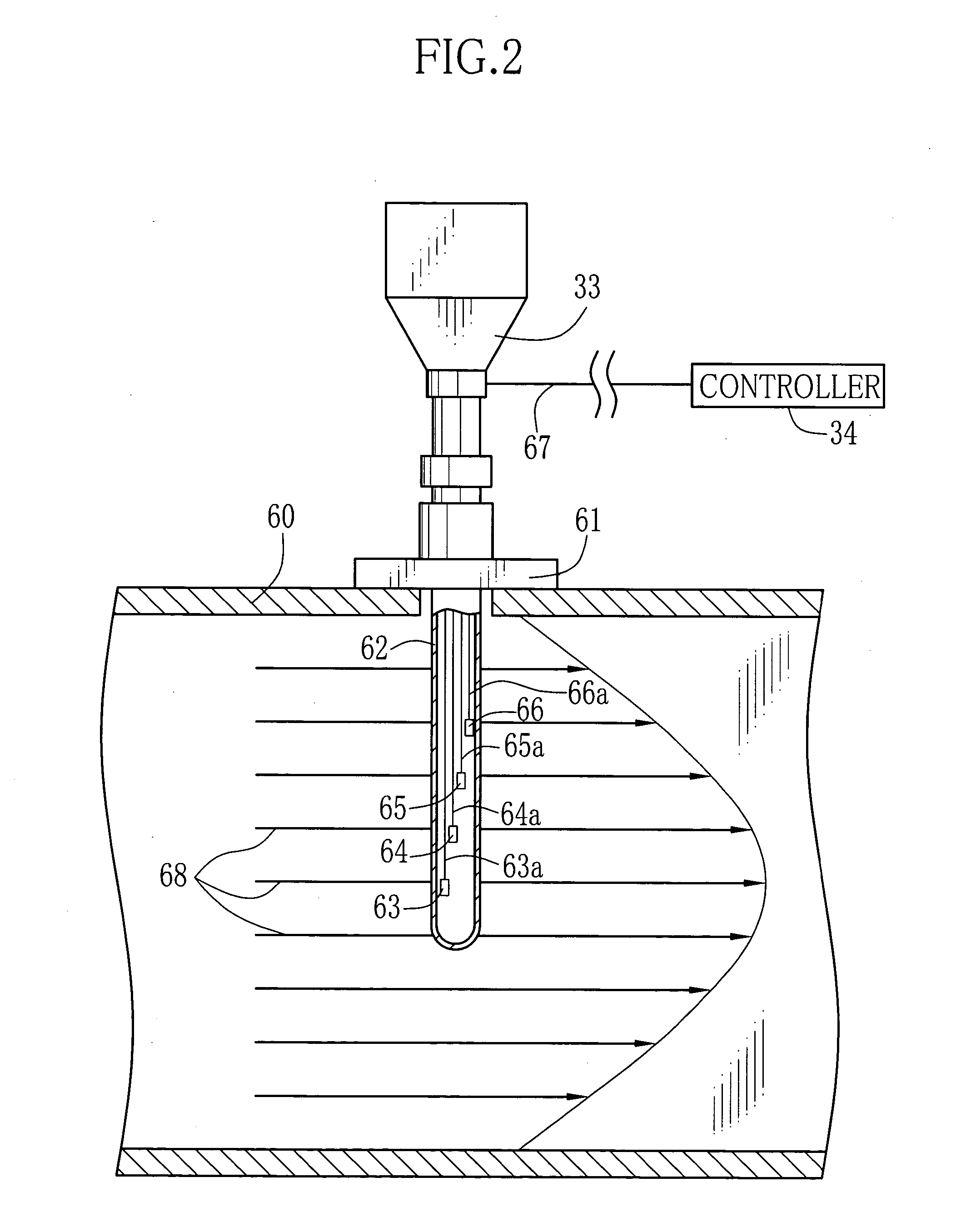Method and apparatus for producing dope
a production equipment and technology of dope, applied in the direction of mixing, polarising elements, coatings, etc., can solve the problems of insufficient heating and cooling ability of the dope producing equipment, difficult dissolution progress, and insufficient heating and cooling, so as to achieve excellent optical properties, reduce the generation of temperature distribution, and excellent heat dissipation
- Summary
- Abstract
- Description
- Claims
- Application Information
AI Technical Summary
Benefits of technology
Problems solved by technology
Method used
Image
Examples
example 1
Example 1 of the dope producing method of the present invention was made. The dope was produced in the dope production line 10 in FIG. 1. The solvent was the dichloromethane type mixture solvent in which the dichloromethane and mixture alcohol (mixture ratio, methanol:n-butanol=34:1) were mixed in the weight ratio of 83:17. Further, the acetylation percentage of TAC was 60%. The plasticizer was the mixture of TPP and BDP in ratio of 2:1 in weight. The solvent, TAC and the plasiciser were supplied in ratio of 77.8 wt. %, 20.0 wt. %, 2.2 wt. % into the dissolution tank 12. The motor 20 was driven to generate such a 45 kW stirring power that the rotation number of the stirrer might be 80 rpm. Thus the rotation was made for 30 minutes to obtain the dissolving solution. Further., the store tank 23 contains the dope previously prepared. As each heat exchanger 31, 35, a spiral type heat exchanger (produced by Kurose Chemical Equipment Co., Ltd.) is used. Further, the static mixer 32 has a...
example 2
In order to produce the dope of Example 2, the following materials were used.
Cellulose triacetate 14.5 pts. wt.(Powder; degree of substitution, 2.82; viscometricaverage degree of polymerization, 320; moisture content,0.4 wt. %; viscosity of 6% by mass of dichloromethanesolution, 305 mPa · s; averaged particle diameter,1.5 mm; standard deviation, 0.5 mm.) (Solvent)Methyl acetate67.69 pts. wt.Acetone 10 pts. wt.Acetone 6.69 pts. wt.Ethanol 5.85 pts. wt.n-butanol 3.34 pts. wtPlasticizer A (ditrimethylolpropanetetraacetate) 0.29 pts. wt.Plasticizer B (Triphenyl phosphate) 0.91 pts. wt.Plasticizer C (biphenyldiphenylphosphate) 0.54 pts. wt.Plasticizer D (ethylphthalylgrycol ethylester)0.091 pts. wt.UV-absorbing agent a 0.05 pts. wt.(2,4-bis-(n-octylthio)-6-(4-hydroxy-3,5-di-tert-butylanylino)-1,3,5-triazine)UV-absorbing agent b 0.05 pts. wt.(2-(2′-hydroxy-3′,5′-di-tert-butylphenyl)-5-chrolobenzotriazol)UV-absorbing agent c 0.1 pts. wt.(2-(2′-hydroxy-3′,5′-di-tert-amilphenyl)-5-chrolo...
PUM
| Property | Measurement | Unit |
|---|---|---|
| temperature | aaaaa | aaaaa |
| temperature | aaaaa | aaaaa |
| diameter | aaaaa | aaaaa |
Abstract
Description
Claims
Application Information
 Login to View More
Login to View More - R&D
- Intellectual Property
- Life Sciences
- Materials
- Tech Scout
- Unparalleled Data Quality
- Higher Quality Content
- 60% Fewer Hallucinations
Browse by: Latest US Patents, China's latest patents, Technical Efficacy Thesaurus, Application Domain, Technology Topic, Popular Technical Reports.
© 2025 PatSnap. All rights reserved.Legal|Privacy policy|Modern Slavery Act Transparency Statement|Sitemap|About US| Contact US: help@patsnap.com



